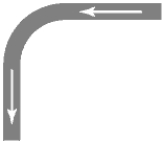Multiple Choice
The diagram shown represents a portion of a wire in a circuit. A current is flowing in the wire in the direction shown. Under the convention that it is positive charge that flows the electric field points in the direction of the current. How can the electric field change direction where the wire bends? 
A) There is an excess of negative charge in the center of the wire.
B) There is an excess of positive charge at the bottom end of the wire.
C) There is an excess of negative charge at the right end of the upper portion of the wire.
D) There is an accumulation of positive charge on the surface, particularly at the bend, such that the sum of electric fields gives the new electric field.
E) There is an accumulation of electrical potential as the current traverses the wire: The higher potential in the lower half is the source of the field.
Correct Answer:

Verified
Correct Answer:
Verified
Q39: At what rate is thermal energy generated
Q40: The circuit below shows three resistors in
Q41: Determine ε when I = 0.50 A
Q42: An initially uncharged 10-μF capacitor is charged
Q43: The capacitors are completely discharged in the
Q45: At t = 0 the switch S
Q46: What is the potential difference V<sub>B</sub> −
Q47: The circuit below contains three 100-W light
Q48: A circuit consists of N resistors, all
Q49: What is the equivalent resistance between points